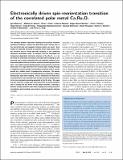Files in this item
Electronically driven spin-reorientation transition of the correlated polar metal Ca3Ru2O7
Item metadata
| dc.contributor.author | Markovic, Igor | |
| dc.contributor.author | Watson, Matthew David | |
| dc.contributor.author | Clark, Oliver Jon | |
| dc.contributor.author | Mazzola, Federico | |
| dc.contributor.author | Abarca Morales, Edgar | |
| dc.contributor.author | Hooley, Chris | |
| dc.contributor.author | Rosner, Helge | |
| dc.contributor.author | Polley, Craig M. | |
| dc.contributor.author | Balasubramanian, Thiagarajan | |
| dc.contributor.author | Mukherjee, Saumya | |
| dc.contributor.author | Kikugawa, Naoki | |
| dc.contributor.author | Sokolov, Dmitry A. | |
| dc.contributor.author | Mackenzie, Andrew | |
| dc.contributor.author | King, Phil D. C. | |
| dc.date.accessioned | 2020-12-23T00:37:38Z | |
| dc.date.available | 2020-12-23T00:37:38Z | |
| dc.date.issued | 2020-07-07 | |
| dc.identifier | 268178651 | |
| dc.identifier | aad97255-ba80-48f6-8c2e-d5b242aa3982 | |
| dc.identifier | 85088087025 | |
| dc.identifier | 000548347200002 | |
| dc.identifier.citation | Markovic , I , Watson , M D , Clark , O J , Mazzola , F , Abarca Morales , E , Hooley , C , Rosner , H , Polley , C M , Balasubramanian , T , Mukherjee , S , Kikugawa , N , Sokolov , D A , Mackenzie , A & King , P D C 2020 , ' Electronically driven spin-reorientation transition of the correlated polar metal Ca 3 Ru 2 O 7 ' , Proceedings of the National Academy of Sciences of the United States of America , vol. 117 , no. 27 , pp. 15524-15529 . https://doi.org/10.1073/pnas.2003671117 | en |
| dc.identifier.issn | 0027-8424 | |
| dc.identifier.other | ORCID: /0000-0002-9976-2405/work/77131147 | |
| dc.identifier.other | ORCID: /0000-0002-1631-9556/work/77131777 | |
| dc.identifier.other | ORCID: /0000-0002-0737-2814/work/77131837 | |
| dc.identifier.uri | https://hdl.handle.net/10023/21189 | |
| dc.description | Funding: We gratefully acknowledge support from the European Research Council (through the ERC-714193-QUESTDO project), the Royal Society, the UK Research and Innovation (via grant numbers EP/R031924/1 and EP/R025169/1), the Max-Planck Society, and the Japan Society for the Promotion of Science KAKENHI (Nos. JP17H06136 and JP18K04715) and Japan Science and Technology Agency JST-Mirai Program (No. JPMJMI18A3). IM and EAM acknowledge studentship support through the International Max-Planck Research School for the Chemistry and Physics of Quantum Materials. We thank Ulrike Nitzsche for thechnical support with the DFT calculations. We thank Diamond Light Source and Max-IV synchrotrons for access to Beamlines I05 (Proposal Nos. SI21986 and SI25040) and BLOCH (Proposal No. 20180399), respectively, that contributed to the results presented here. | en |
| dc.description.abstract | The interplay between spin–orbit coupling and structural inversion symmetry breaking in solids has generated much interest due to the nontrivial spin and magnetic textures which can result. Such studies are typically focused on systems where large atomic number elements lead to strong spin–orbit coupling, in turn rendering electronic correlations weak. In contrast, here we investigate the temperature-dependent electronic structure of Ca3Ru2O7, a 4d oxide metal for which both correlations and spin–orbit coupling are pronounced and in which octahedral tilts and rotations combine to mediate both global and local inversion symmetry-breaking polar distortions. Our angle-resolved photoemission measurements reveal the destruction of a large hole-like Fermi surface upon cooling through a coupled structural and spin-reorientation transition at 48 K, accompanied by a sudden onset of quasiparticle coherence. We demonstrate how these result from band hybridization mediated by a hidden Rashba-type spin–orbit coupling. This is enabled by the bulk structural distortions and unlocked when the spin reorients perpendicular to the local symmetry-breaking potential at the Ru sites. We argue that the electronic energy gain associated with the band hybridization is actually the key driver for the phase transition, reflecting a delicate interplay between spin–orbit coupling and strong electronic correlations and revealing a route to control magnetic ordering in solids. | |
| dc.format.extent | 6 | |
| dc.format.extent | 5699492 | |
| dc.language.iso | eng | |
| dc.relation.ispartof | Proceedings of the National Academy of Sciences of the United States of America | en |
| dc.subject | Ruthenate | en |
| dc.subject | Magnetism | en |
| dc.subject | Correlated oxide | en |
| dc.subject | Rashba spin-orbit | en |
| dc.subject | Angle-resolved photoemission | en |
| dc.subject | QC Physics | en |
| dc.subject | TK Electrical engineering. Electronics Nuclear engineering | en |
| dc.subject | DAS | en |
| dc.subject.lcc | QC | en |
| dc.subject.lcc | TK | en |
| dc.title | Electronically driven spin-reorientation transition of the correlated polar metal Ca3Ru2O7 | en |
| dc.type | Journal article | en |
| dc.contributor.sponsor | EPSRC | en |
| dc.contributor.sponsor | European Research Council | en |
| dc.contributor.sponsor | EPSRC | en |
| dc.contributor.sponsor | The Royal Society | en |
| dc.contributor.institution | University of St Andrews. Centre for Designer Quantum Materials | en |
| dc.contributor.institution | University of St Andrews. School of Physics and Astronomy | en |
| dc.contributor.institution | University of St Andrews. Condensed Matter Physics | en |
| dc.identifier.doi | https://doi.org/10.1073/pnas.2003671117 | |
| dc.description.status | Peer reviewed | en |
| dc.date.embargoedUntil | 2020-12-23 | |
| dc.identifier.grantnumber | EP/R031924/1 | en |
| dc.identifier.grantnumber | 714193 | en |
| dc.identifier.grantnumber | EP/R015511/1 | en |
| dc.identifier.grantnumber | URF/R/180026 | en |
This item appears in the following Collection(s)
Items in the St Andrews Research Repository are protected by copyright, with all rights reserved, unless otherwise indicated.

